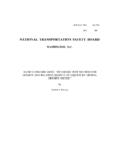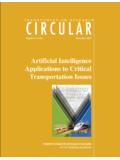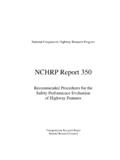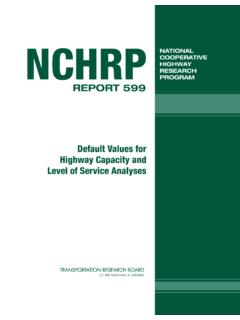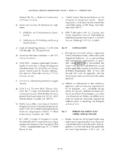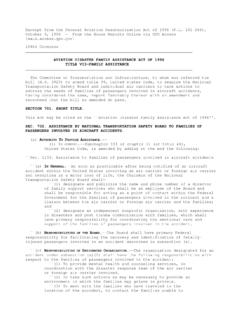Transcription of NATIONAL TRANSPORTATION SAFETY BOARD
1 DOCKET 516 EXHIEUTNO. 8 JNATIONAL TRANSPORTATION SAFETY BOARDWASHINGTON, STANDARD D86: STANDARD TEST METHOD FORDISTILLATION OF PETROLEUM PRODUCTS. Gordon J. Hookey#Tb Designation: D 86 - 95 An American NATIONAL Standard Standard Test Method for Distillation of Petroleum Products This standard is issued under the fixed designation D 86, the number immediately following the designation indicates the year of original adoption or, in the case of revision, the year of last revision. A number in parentheses indicates the year of last reapproval. A superscript epsilon (t) indicates an editorial change since the last revision or reapproval.
2 This standard has been approved for use by agencies of the Department of Defense. Consult the DOD inde? of Specijications and Standards for the specific year of issue which has been adopted by the Department of Defense. 1. Scope I .l This test method covers the distillation of natural gasolines, motor gasolines, aviation gasolines, aviation tur- bine fuels, special boiling point spirits, naphthas, white spirit, kerosines, gas oils, distillate fuel oils, and similar petroleum products, utilizing either manual or automated equipment. In cases of dispute, the referee test method is the manual test method prepared as directed for the indicated group.
3 The values stated in SI units are to be regarded as the standard. The values given in parentheses are provided for in formation only. This standard does not purport to address all of the ,sufety concerns, if any, associated with its use. It is the responsibility of the user of this standard to establish appro- priate SAFETY and health practices and determine the applica- bility of regulatory limitations prior to use. 2. Referenced Documents ASTM Standards: D 323 Test Method for Vapor Pressure of Petroleum Products (Reid Method)2 D 396 Specification for Fuel Oils2 D 850 Test- Method for Distillation of Industrial Aromatic Hydrocarbons and Related Materials3 D 975 Specification for Diesel Fuel Oils2 D 1078 Test Method for Distillation Range of Volatile Organic Liquids3 D 2892 Test Method for Distillation of Crude Petroleum ( 1%Theoretical Plate Column)
4 4 D 4057 Practice for Manual Sampling of Petroleum and Petroleum Products4 D 4 177 Practice for Automatic Sampling of Petroleum and Petroleum Products4 D 4953 Test Method for Vapor Pressure of Gasoline and Gasoline Oxygenate Blends (Dry Method)s D 5 190 Test Method for Vapor Pressure of Petroleum Products (Automatic Method)s 1 This test method is under the jurisdiction of ASTM Committee D-2 on l crr~~leum Products and Lubricants and is the direct responsibility of Subcom- tnittee on Volatility. In the IP. this test method is under the jurisdiction of the Standardization ( ummittee. ( urrenl edition approved Jan. 15, 1995.))
5 Published March 1995. Originally l~ublkhed as D 86 - 21. Last previous edition D 86 - 93. 2 .+tnual Book of ASTM Standards, Vol .4nntrol Book of ASTM Standards, Vol 4 .~tmual Book o/ASTM Standards, Vol annual Book of ASTM Standards, Vol D 5 19 1 Test Method for Vapor Pressure of Petroleum Products (Mini Method)5 D5482 Test Method for Vapor Pressure of Petroleum Products (Mini Method-Atmospheric)5 E 1 Specification for ASTM Thermometer@ E 77 Test Method for Inspection and Verification of Thermometer@ E 133 Specification for Distillation Equipment E 220 Method for Calibration of Thermocouples by Com- parison Technique@ IP 69 Determination of Vapour Pressure-Reid Method8 IP 17 1 Vapour Pressure Micro Method9 3.
6 Terminology Descriptions of Terms Specific to This Standard: decomposition point-the thermometer reading that coincides with the first indications of thermal decomposition of the liquid in the flask. DlscussroN-Characteristic indications of thermal decomposition are an evolution of fumes, and erratic thermometer readings that usually decrease after any attempt is made to adjust the heat. dry point-the thermometer reading that is observed at the instant the last drop of liquid evaporates from the lowest point in the flask. Any drops or film of liquid on the side of the flask or on the thermometer are disregarded. DIscussroN-The end point (final boiling point), rather than the dry point, is intended for general use.
7 The dry point can be reported in connection with special purpose naphthas, such as those used in the paint industry. Also, it is substituted for the end point (final boiling point) whenever the sample is of such a nature that the precision of the end point (final boiling point) cannot consistently meet the require- ments given in the Precision Section. end point or fmal boiling point-the maximum thermometer reading obtained during the test. This usually occurs after the evaporation of all liquid from the bottom of the flask. The term maximum temperature is a frequently used synonym. initial boiling point-the thermometer reading that is observed at the instant that the first drop of condensate falls from the lower end of the condenser tube.
8 Percent evaporated-the sum of the percent recov- ered and the percent loss. 6 Annual Book of ASTM Standards, Vol r 7 Annual Book of ASTM Standards, Vol * Available from The Institute of Petroleum, 6 I New Cavendish St., London, W 1 M 8AR, England. 9 Withdrawn 1992, contact The Institute of Petroleum for availability, 1 6 i refe E 1. con 6. Spec r: as sl 1 (of: 6. and E 13 6.: E 13 Boar (2-in. ! percent loss-one hundred minus the percent total recovery. percent recovered-the volume in millilitres of con- densate observed in the receiving graduate, in connection with a simultaneous thermometer reading. percent recovery-the maximum percent recovered, as observed in accordance with percent residue-the volume of residue in millilitres measured in accordance with percent total recovery-the combined percent re- covery and residue in the flask, as determined in accordance with thermometer reading-the temperature of the sat- urated vapor measured in the neck of the flask below the vapor tube.))
9 4. Summary of Test Method A 100 mL sample is distilled under prescribed condi- tions that are appropriate to its nature. Systematic observa- tions of thermometer readings and volumes of condensate are made, and from these data, the results of the test are calculated and reported. 5. Significance and Use The distillation (volatility) characteristics of hydrocar- bons often have an important effect .on their SAFETY and performance, especially in the case of fuels and solvents. Volatility is the major determinant of the tendency of a hydrocarbon to produce potentially explosive vapors. It is also critically important for both automotive and aviation gasolines, affecting starting, warmup, and tendency to vapor lock at high operating temperature or at high altitude, or both.
10 The presence of high boiling point components in these and other fuels can significantly affect the degree of formation of solid combustion deposits. Volatility, as it affects rate of evaporation, is also an important factor in the application of many solvents, partic- ularly those used in paints. Petroleum product specifications generally include distillation limits to assure products of suitable volatility performance. 6. Apparatus ,, Unless noted otherwise, all of the section and tigure reference numbers in through refer to Specification , the specification to which all the items Listed shall conform. Flask-Flask A (100 mL), as shown in Fig.
